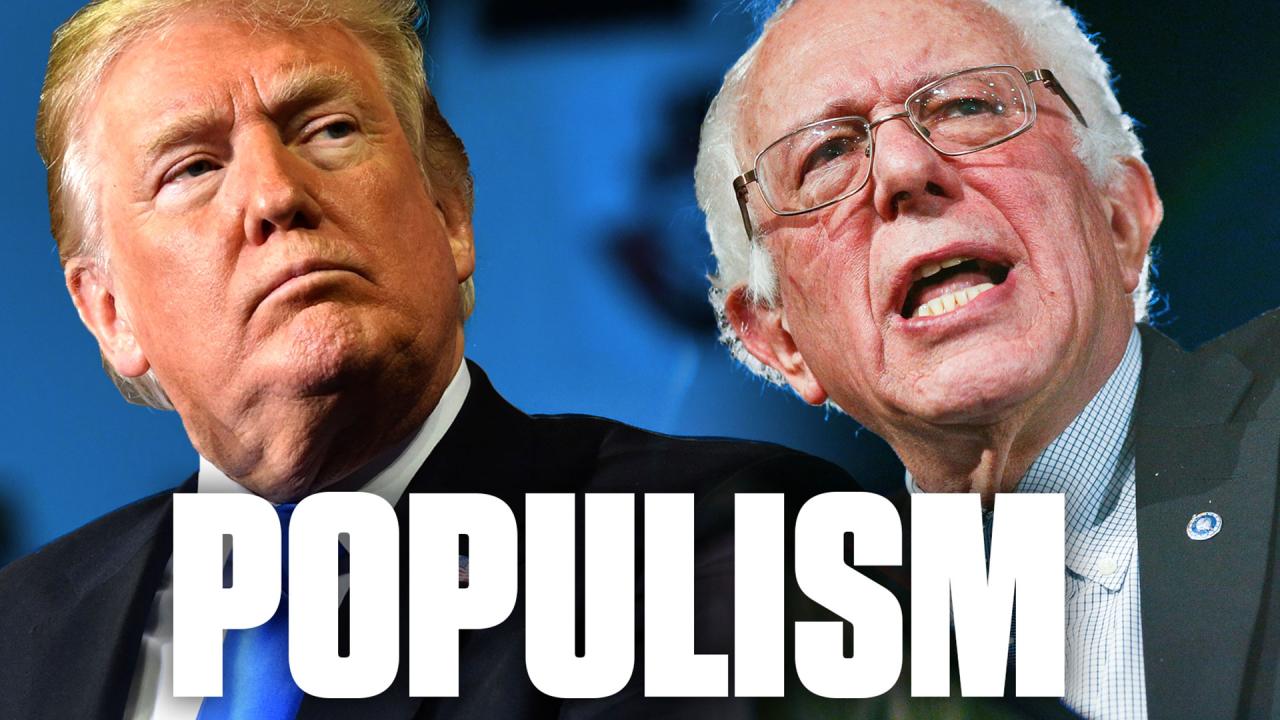
Why Populism Is Good To A Point
Why popularism is good to a point – Why populism is good to a point? It’s a question that’s been swirling in my mind lately, and I’m sure it’s been on yours too. Populism, with its promise of direct connection to the people and its rejection of the elite, seems to hold a certain allure.
But, as with most things, there’s a fine line between a healthy dose of people-powered politics and a dangerous slide towards authoritarianism.
Populism, at its core, is a response to a perceived disconnect between the people and the governing class. It’s a cry for change, a yearning for a voice in a system that often feels distant and unresponsive. But the seductive simplicity of populist messaging can also mask a more complex reality.
The very power of direct connection can be used to manipulate, to sow division, and to erode the very institutions that safeguard our freedoms.
The Appeal of Populism

Populism, a political ideology that often presents itself as a champion of the “ordinary people” against a perceived elite, has experienced a resurgence in recent decades. While populist movements can offer a voice to those who feel unheard and disenfranchised, their appeal can also be rooted in complex psychological and sociological factors.
Factors Contributing to the Appeal of Populism
The appeal of populism can be attributed to a combination of psychological and sociological factors. These factors often tap into anxieties and frustrations within a society, providing a seemingly simple solution to complex problems.
- Economic Anxiety:Populist movements often capitalize on economic anxieties, promising to “restore” prosperity and “take back” jobs from foreign competition. This resonates with individuals who feel left behind by globalization and economic inequality.
- Cultural Identity:Populist leaders often evoke a sense of national or cultural identity, emphasizing a shared history and values. This can be particularly appealing in times of social and cultural change, when individuals may feel a sense of displacement or loss of identity.
- Political Disillusionment:When people lose faith in traditional political institutions and feel that their voices are not being heard, populist movements can offer an alternative. They often present themselves as outsiders who are not beholden to the “establishment” and can challenge the status quo.
Popularism can be a powerful force for change, but it’s important to remember that it can also be manipulated and exploited. This is especially true when it comes to issues like abortion rights, where the voices of the most vulnerable can be drowned out by the loudest voices.
It’s worth asking, “Will the pro-abortion rights billionaires please stand up?” will the pro abortion rights billionaires please stand up and amplify the voices of those who are most affected by these decisions. Ultimately, the goal should be to create a more equitable and just society, and popularism can be a tool for achieving that, but only if it’s used responsibly.
- Fear of the Other:Populist movements often exploit fear and prejudice, scapegoating “outsiders” for societal problems. This can take the form of xenophobia, racism, or homophobia, creating a sense of threat and justifying exclusionary policies.
Historical and Contemporary Populist Leaders
Populist movements have a long history, with examples from various eras and regions. Here are some notable historical and contemporary leaders:
- Andrew Jackson (USA):Known for his “common man” appeal, Jackson’s presidency (1829-1837) is considered a significant moment in the development of American populism. He championed the rights of ordinary citizens against the perceived power of elites.
- Huey Long (USA):A controversial figure in the 1930s, Long advocated for social welfare programs and challenged the existing political order. He gained significant support by appealing to the economic anxieties of the Great Depression era.
- Donald Trump (USA):Trump’s rise to power in 2016 was fueled by his populist rhetoric, which focused on issues such as immigration, trade, and economic inequality. He appealed to voters who felt disenfranchised by the political establishment.
- Viktor Orbán (Hungary):Orbán, who has been Prime Minister of Hungary since 2010, has adopted a populist agenda, emphasizing national sovereignty and cultural identity. He has also criticized the European Union and promoted a more authoritarian style of governance.
- Rodrigo Duterte (Philippines):Duterte, who served as President of the Philippines from 2016 to 2022, gained popularity through his tough stance on crime and his anti-establishment rhetoric. He has also been criticized for his human rights record and his authoritarian tendencies.
Populist Movements Across the World
Populist movements have emerged in various countries and regions, often reflecting local concerns and grievances.
- Latin America:Populist leaders such as Hugo Chávez in Venezuela and Evo Morales in Bolivia gained significant support by appealing to the economic and social disparities in their countries. They often promoted socialist policies and challenged the influence of Western powers.
- Europe:The rise of far-right and nationalist parties across Europe, such as the National Front in France and the Alternative for Germany, has been fueled by anti-immigration sentiment, economic anxieties, and concerns about cultural identity.
- Asia:Populist movements have also gained traction in Asia, with leaders such as Narendra Modi in India and Rodrigo Duterte in the Philippines appealing to nationalist sentiment and promising to restore national pride.
Tactics and Strategies of Populist Movements
Populist movements often employ a range of tactics and strategies to gain support and influence. These tactics often involve simplifying complex issues, appealing to emotions, and creating a sense of urgency and crisis.
Popularism can be a powerful force for change, giving voice to the concerns of the everyday person. However, it’s important to remember that just like a recipe for flaky, oozy stuffed biscuits, for flaky oozy stuffed biscuits just use store bought dough , sometimes shortcuts can lead to a less-than-ideal outcome.
While popularism can be a valuable tool for highlighting issues, it can also be manipulated for personal gain, making it crucial to maintain a critical eye and a healthy skepticism.
- Simplification of Issues:Populist leaders often reduce complex issues to binary choices, portraying themselves as the only solution to the problem. This allows them to appeal to a wider audience by offering seemingly easy answers to complex challenges.
- Emotional Appeals:Populist movements often appeal to emotions such as fear, anger, and resentment. They use strong language, vivid imagery, and dramatic pronouncements to create a sense of urgency and mobilize their base.
- Creation of an “Us vs. Them” Mentality:Populist leaders often create a sense of division between “ordinary people” and a perceived elite. This strategy allows them to scapegoat the elite for societal problems and gain support by promising to “fight for the people.”
- Use of Social Media:Populist movements have effectively utilized social media to spread their message, bypass traditional media outlets, and connect directly with their supporters. This allows them to reach a wider audience and avoid scrutiny from mainstream media.
Benefits of Populism
Populism, despite its often-criticized aspects, can also bring about positive changes. While its appeal and potential dangers have been discussed, exploring its potential benefits is crucial for a balanced understanding of this complex phenomenon. Populist movements, in their attempts to address grievances and empower the people, can have a significant impact on societies, both positive and negative.
Examining these benefits allows for a more nuanced perspective on populism’s role in shaping the political landscape.
Empowerment of Marginalized Groups
Populist movements can provide a platform for marginalized groups who feel unheard and unrepresented by traditional political systems. By amplifying their voices and championing their concerns, populists can empower these groups and challenge existing power structures. This can lead to increased political participation and a more inclusive political landscape.
- In the United States, the rise of the Tea Party movement in the early 2010s empowered conservative voters who felt their voices were not being heard by the establishment. This movement challenged the status quo and contributed to a shift in the Republican Party’s political agenda.
Popularism can be a powerful force for change, but it’s crucial to remember that the will of the majority doesn’t always align with what’s truly best. Take the issue of abortion rights, for example: America almost took a different path toward abortion rights , one that could have protected women’s bodily autonomy.
This example highlights the need for careful consideration and balanced perspectives, even when faced with the strong pull of popular opinion.
- Similarly, the Occupy Wall Street movement, which emerged in 2011, brought attention to issues of economic inequality and corporate influence in politics, giving voice to those who felt disenfranchised by the financial crisis and its aftermath.
Increased Political Participation
Populist movements often attract individuals who feel disillusioned with traditional politics and believe that the political system is unresponsive to their concerns. By mobilizing these individuals and offering them a sense of agency, populism can lead to increased political participation and engagement.
- The Brexit campaign in the United Kingdom saw a surge in voter turnout, particularly among those who felt alienated from the political establishment and desired a more direct say in their country’s future. This surge in participation highlighted the potential of populist movements to energize voters who might otherwise feel disengaged from the political process.
- The rise of online platforms and social media has further facilitated the spread of populist messages and the mobilization of supporters, enabling individuals to connect and organize around shared grievances and aspirations.
Addressing Corruption and Inefficiency
Populist movements often emerge in response to perceived corruption and inefficiency within the political system. By highlighting these issues and demanding change, populists can challenge the status quo and force governments to address systemic problems.
- The rise of anti-corruption movements in countries like Ukraine and Georgia demonstrates the potential of populist movements to bring about positive change by holding those in power accountable and promoting transparency and accountability in governance.
- In Latin America, populist leaders like Hugo Chávez in Venezuela and Evo Morales in Bolivia promised to address issues of poverty and inequality, appealing to voters who felt neglected by the traditional political elite.
The Perils of Populism: Why Popularism Is Good To A Point
While populism can offer a voice to the marginalized and challenge the status quo, it also carries significant risks that can undermine democratic principles and societal well-being. The allure of simple solutions and the demonization of opponents can lead to harmful consequences, both domestically and internationally.
Erosion of Democratic Institutions
Populist movements often target established institutions, such as the judiciary, the media, and electoral bodies, accusing them of being corrupt or out of touch with the people. This rhetoric can erode public trust in these institutions and undermine their legitimacy.
For instance, populist leaders may attack the judiciary for rulings they disagree with, or they may label the media as “fake news” to discredit critical reporting. Such actions can weaken the checks and balances that are essential for a functioning democracy.
Rise of Authoritarianism
Populism can pave the way for authoritarianism by concentrating power in the hands of a single leader or a small group. Populist leaders often exploit fears and anxieties to consolidate their power, using tactics like scapegoating, demonizing opponents, and suppressing dissent.
They may also weaken or dismantle independent institutions that could challenge their authority.
Increased Social Division and Polarization
Populist rhetoric often relies on dividing society into “us” versus “them,” pitting the “real people” against the “elites” or “outsiders.” This can lead to increased social division and polarization, making it harder to find common ground and address shared challenges.
Populist leaders may also exploit existing social divisions, such as those based on race, religion, or ethnicity, to mobilize their base and gain political advantage.
Suppression of Dissent and Minority Rights
Populist movements often exhibit intolerance towards dissenting voices and minority groups. They may suppress criticism, silence opponents, and restrict freedom of speech. This can lead to a climate of fear and intimidation, where individuals are reluctant to express their views or challenge the dominant narrative.
In some cases, populist leaders have even resorted to violence or intimidation against political opponents and minority groups.
Manipulating Public Sentiment
Populist leaders are skilled at manipulating public sentiment by appealing to emotions, simplifying complex issues, and exploiting anxieties. They often use inflammatory language, misleading information, and conspiracy theories to create a sense of urgency and fear, which can lead to a demand for quick and decisive action.
This can be particularly effective in times of economic hardship or social unrest, when people are more susceptible to fear-mongering and simplistic solutions.
Examples of Negative Outcomes, Why popularism is good to a point
History provides numerous examples of populist movements that have resulted in negative outcomes. In the 20th century, the rise of fascism in Italy and Germany led to authoritarian regimes, war, and genocide. More recently, the election of populist leaders in countries like Venezuela, Turkey, and Hungary has been accompanied by the erosion of democratic institutions, the suppression of dissent, and the weakening of the rule of law.
Addressing the Negative Consequences
Addressing the negative consequences of populism requires a multi-faceted approach. This includes:
- Promoting media literacy and critical thinking skills to help citizens discern fact from fiction.
- Strengthening democratic institutions and promoting civic engagement to ensure that they are responsive to the needs of the people.
- Addressing the underlying social and economic grievances that fuel populism, such as inequality, poverty, and lack of opportunity.
- Encouraging dialogue and understanding across political and social divides to foster a more inclusive and tolerant society.
Closing Summary

Navigating the complexities of populism requires a careful balance. We need to acknowledge the legitimate grievances that fuel its rise, while simultaneously guarding against the dangers of its excesses. We must find ways to engage with the frustrations of the people, to offer real solutions, and to strengthen our democratic institutions.
Only then can we harness the potential benefits of populism without succumbing to its perils.






